- Home ›
- NZ Regions ›
- West Coast ›
- Hokitika
Hokitika New Zealand
Hokitika is a vibrant and famous historic town located on the wild and rugged West Coast of the New Zealand South Island on SH6, about 40km south of Greymouth.
Hokitika Driftwood Sign on Hokitika Beach
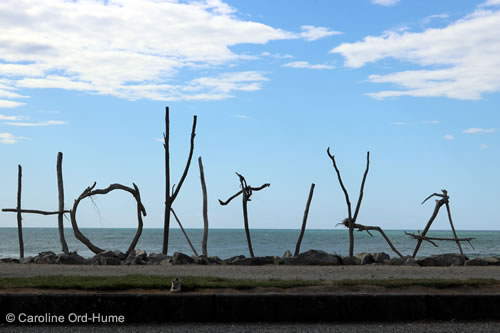
Hokitika town is well known for its many arts and crafts, most famous being Maori jade and bone carving.
This is jade / pounamu (greenstone) country, so if you are looking for jade carving it is worth spending some time having a good look in the shops and studios in Hokitika, particularly for a unique piece from a local carver.
Hokitika Town Clock Tower on Sewell Street
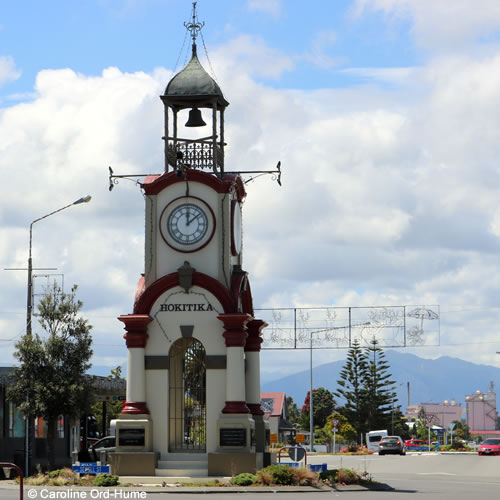
Hokitika Things to Do
There is a wide variety of things to do in Hokitika and the surrounding area for days trips and tours. Here are a few of the most well known and best attractions that this cool little town is known for.
- Hokitika Beach
- Arts and Crafts Galleries
- Jade Carving / pounamu / greenstone
- Glass Blowing
- Arahura Greenstone Tours
- Bone Carving
- Hokitika Museum
- Sock World Hokitika
- National Kiwi Centre
- Hokitika Wildfoods Festival (March) and Hokitika Driftwood Competition
- Hokitika Gorge - Hokitika Gorge Walk and Track Photos
- Koiterangi Incident Memorial
- Lake Kaniere
- Hiking and Walking - Hokitika Walks that take 5 minutes, to hikes that take several days
- Cycle Trails and the West Coast Wilderness Trail
- Driftwood Sculpture on Hokitika Beach
- Hokitika Historic Landmarks Walks
- Scenic Flights
- Gold Panning (Goldsborough and Ross). See further down the page...
What's the Time in Hokitika?
The time in Hokitika New Zealand is...
Driftwood on the Beach at Hokitika
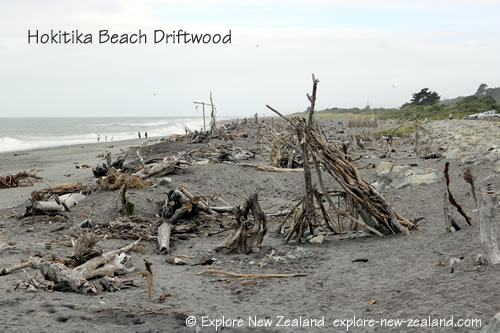
Hokitika Attractions
- Hokitika - Jade / Pounamu / Greenstone
- Hokitika - Whitebaiting and fishing
- Hokitika Glow Worm Dell
- Hokitika Walks
- Hokitika Gorge Scenic Reserve
- Lake Kaniere
- Dorothy Falls
- Lake Kaniere Scenic Reserve
Also see West Coast Region information for lists of places all down the coast along with suggestions of things to do in the wider area beyond Hokitika Town.
Hokitika Beach Sunset in February
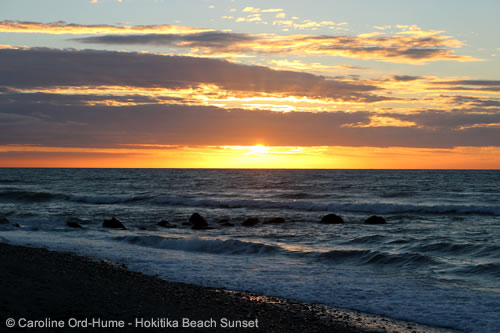
Hokitika Gold Rush
Hokitika is one of the towns that historically played a big part in the New Zealand gold rush. In late 1864 payable gold was discovered and the town had to expand to cater for the huge rise in population of gold diggers hoping to make their fortune looking for gold in nearby rivers.
The Port of Hokitika Picture - 1867
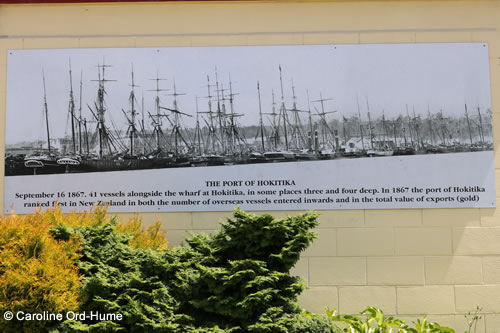
Text with the photograph in the image above...
"Port of Hokitika
September 16 1867. 41 vessels alongside the wharf at Hokitika, in some places three and four deep. In 1867 the Port of Hokitika ranked first in New Zealand in both the number of overseas vessels entered inwards and in the total value of exports (gold)."
Streets were named in the expanding town and have now become familiar to readers of The Luminaries, some of which visit Hokitika to look for specific places mentioned in the novel by Eleanor Catton.
The West Coast is steeped in history from the South Island gold rush.
Hokitika Quayside
‘The Quayside’
The text from The Quayside information board image has been typed up for you to read below the image, including captions of the photographs that are provided on the board.
Hokitika Historic Quayside Sign
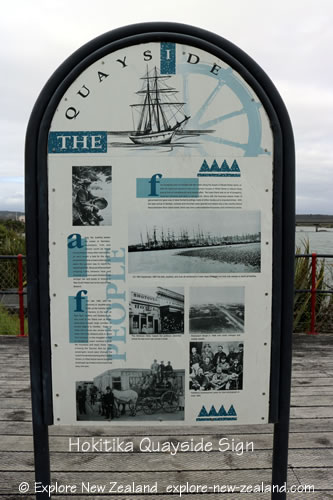
"The Quayside
The straggling town of Hokitika with 80 hotels along the beach in Revell Sreet alone, or with the tightly jam-packed hotels and business houses in Wharf Street or Gibson Quay was at first an unsubstantial and rickety affair. But soon there was an air of prosperity, once he hurriedly built tents or ponga huts, along with the business places made of galvanised iron gave way to false-fronted buildings made of either locally cut or imported timber. With the later arrival of families, schools and churches were opened and where only a few months before there had been thick native forest, there was now a well-established business and commercial centre.
Along the bustling streets the voices of Germans, Australians, Irish and Italians could be heard among those of many other nationalities, as each sought a bed for the night, somewhere to have a meal or else inquired about the quickest way to reach the nearest gold field. Because of the constant shipping traffic between here and Australia, for several years Westland had stronger ties and loyalty to Victoria or New South Wales than to the rest of New Zealand.
From late 1864 with the discovery of payable gold-fields up the Hokitika River at Kaniere, to the north at Blue Spur, Stafford and Goldsborough, and south at the Totara rush at Ross, gold rushes brought large numbers of excited diggers to Hokitika. Eager to make their fortune men arrived by sea either from New Zealand ports or direct from overseas, or else struggled on foot or travelled by coach overland through the mountains and heavy forest. After crossing the Tasman Sea by ship, passengers would pass through the custom house before joining other hopeful miners, or if they had an eye for business would open up a hotel or store close to the busy river port."
Pictures captions on sign
"On 16th September 1867 the tide, weather, and river all combined to make ideal conditions for forty one vessels to berth at Hokitika.
The Shotover Hotel helped the publican advertise where he had once had owned a hotel.
Fitzherbert Street in 1906 with small cottages and muddy streets.
Hokitika’s businessmen pose for their photograph in early 1865."